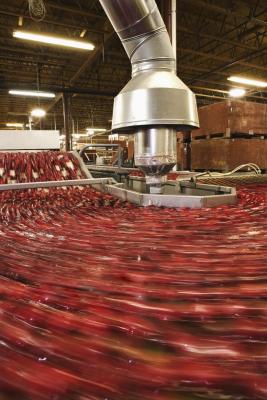
Tank agitators are used in tank vessels to mix a liquid or slurry at a slow revolution. A top-entry agitator is a common design that uses a flanged or plate-mounted mixer that sits atop the process tank. Other designs are used for different applications, depending upon the material being mixed. Agitators can be mounted on the tank's sides or bottom, if height clearance is a problem. Knowing what type and size agitator to use for a tank takes several calculations and considerations.
Measure the dimensions of the processing tank, from the top, bottom and sides with a tape measure. Sketch the profile of the tank with pen and paper. The profile of the tank will determine the type of mounting plate. Determine the clearance between the tank and any obstruction. Tank size also determines the length of the drive shaft from the motor to the impellers -- the mixing blades that blend the processing material.
Determine which brand of tank agitator you favor. For instance, Rittenhouse specializes in spray agitators that mix wettable powders. The Grainger company makes fluid, paint, laboratory and common tank agitators. Lee Industries has models designed for all stainless-steel tanks.
Determine if you might need explosion prevent motors, which are sealed motors that keep stray sparks from igniting a processing mixture, such as alcohol or a petroleum-based mixture. Make a note of the type of material or liquid you are processing. Read service manuals and reviews, for performance data, warranty and other specifications.
Determine which type of gear box is needed. A manual gear box controls the speeds of the motor. Gear boxes can also be programmable, set by a timer to mix materials at certain speeds and times.
Look at your tank specifications placard to find the tank volume in gallons. Record your processing materials, like if you use two or more light liquids in a batch.
Determine if you have slurries mixed with solids, which might include blocks of solid cheese mixed with a heavy cooking oil. All these determinations provide thickness ratings, starting from light materials to solids. This also helps to determine how strong the agitator motor must be to mix the different blends.
Use a 1/20-horsepower motor for a 30- to 50-gallon tank, if you are mixing two or more light liquids. For 100-gallon tanks, use a 1/4-horsepower motor. Use a 1/3-horsepower motor for a 275-gallon tank and a 1/2-horsepower motor for a 500-gallon tank.
Use a 1/4-horsepower motor for a 30- to 50-gallon tank, when mixing light slurries that have 5 percent solids. Use a 1-horsepower motor for a 100-gallon tank. Use a 1/3-horsepower motor for tanks ranging from 275 to 500 gallons.
Use a 1/4-horsepower motor for a 30-gallon tank, if you are mixing a medium slurry with 20 percent solids. This will be the heaviest, or thickest, mixture you'll approach. From tanks measuring from 50 to 500 gallons, use a 1/3-horsepower motor.